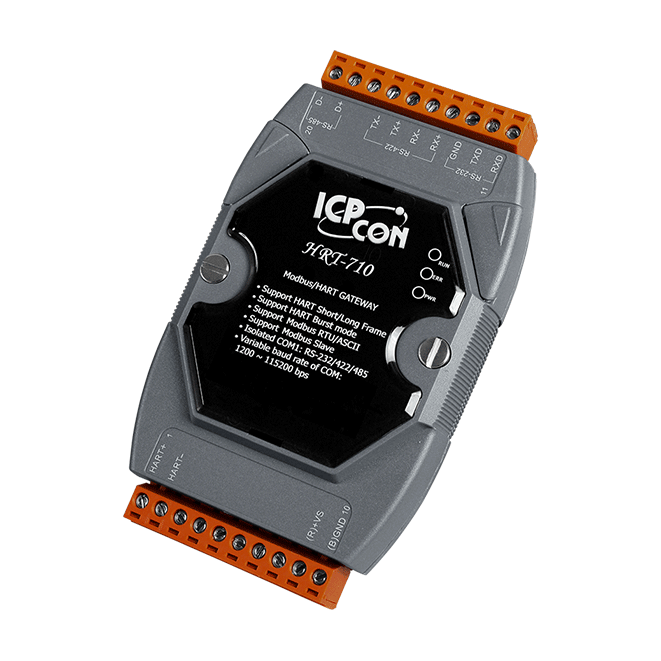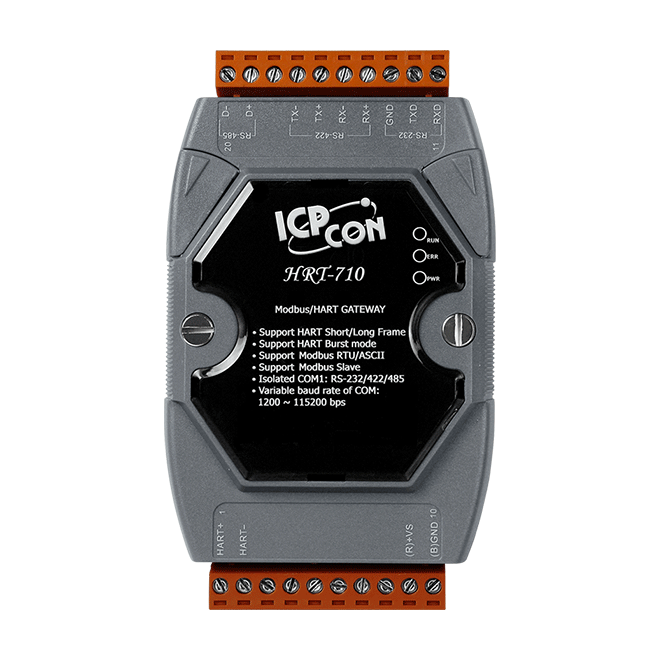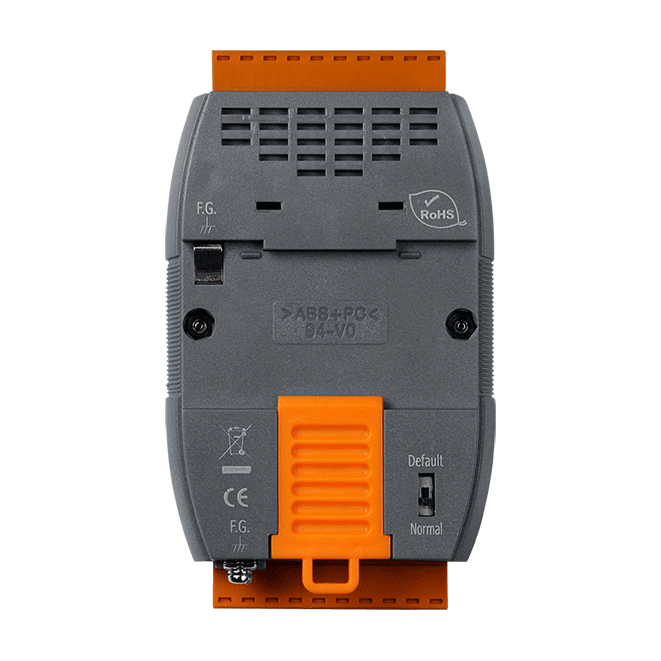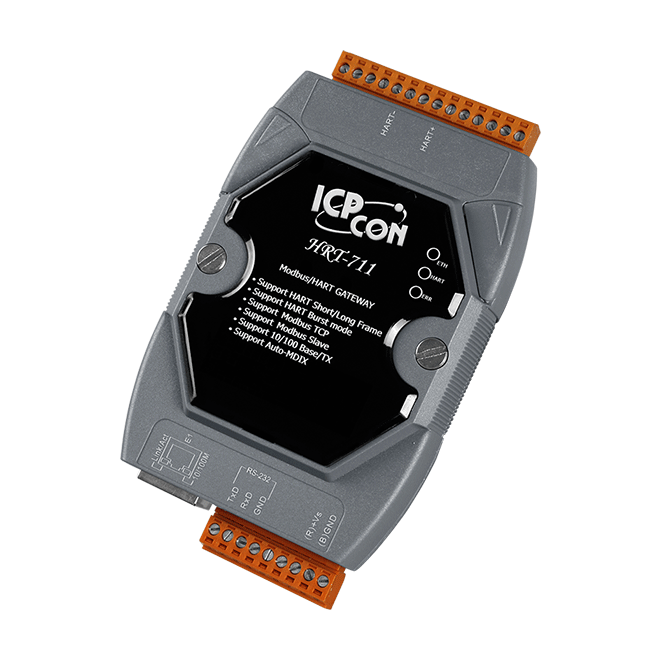HRT-710
Introduction
The HRT-710 Gateway is specially designed for the master device of HART protocol. It allows the Modbus master to access the HART devices. These HART devices may be a transmitter, an actuator and so forth. In addition, we also provide the software utility, HG_Tool, for module configuration and HART device diagnosis. By using these modules, users can integrate their HART devices into Modbus network easily and quickly.
_application.jpg)
| Model | HRT-710 | HRT-310 |
|---|---|---|
| Din Rail Installation | Horizontal | Upright |
| HART Signal | Standard | Enhanced send/receive signal (For long distance comm.) |
| Loop Power | No | Support (module provides +30V output) |
| Built-In Resistor | 250 Ohm (1/4W) | 250 Ohm (1W) |
Applications

- Industrial Automation
- Factory Automation
- Process Automation
- Etc…
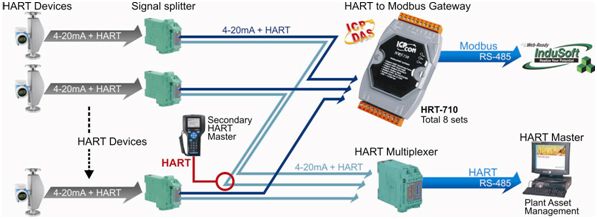
HRT-710, a HART master to Modbus slave gateway, is applied to integrate the information from these HART flow meters into the customer's HMI system. Through the HRT-710, all of the HART flow meters will be regarded as Modbus slave devices and the HMI system can use the built-in Modbus RTU communication to access these HART flow meters easily.
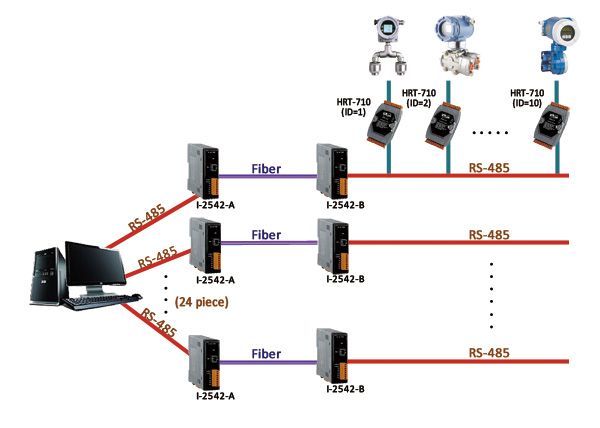
More than 250 HART device information needs to be integrated to surveillance center. In PC side, uses 3 pieces of PCI cards (VXC-148U, for 24 channels RS-485 expansion). I-2542A and I-2542B (RS-485 to Fiber) are used in every RS-485 channel to extend RS-485 communication distance. There are about 20 pieces of HRT-710 modules used in every RS-485 channel with the different station ID. Through the structure, SCADA or HMI system can integrate all HART device information via Modbus protocol easily and quickly.
Ordering Information
| PRODUCT SERIES | DESCRIPTION | QNT. | INQUIRY |
|---|---|---|---|
Similar Products
| COM Ports | |
|---|---|
| Ports | RS-232(3 wires) / RS-422 / RS-485 |
| Baud Rate | 1200, 2400, 4800, 9600, 19200, 38400, 57600, 115200 |
| Protocol | Modbus RTU / Modbus ASCII |
| HART | |
|---|---|
| Ports | 1 |
| Device | 2-wired or 4-wired HART devices |
| Topology | Point to Point or Multi-Drop |
| Data | Only Digital Data |
| Frame Type | Short and Long Frame |
| Burst Mode | Supported |
| Max. HART Device | 15 |
| Loop Resistor | 250 Ω (1/4W) by Jumper |
| Isolation | UL1577 Spec. |
| Protocol | 2-pin screwed terminal block |
| Loop Power | No |
| Power | |
|---|---|
| Reverse Polarity Protection | Power reverse polarity protection, Over-voltage brown-out protection |
| Input Range | Unregulated +10 ~ +30 VDC |
| Consumption | 1 W |
| Mechanical | |
|---|---|
| Dimensions (mm) | 72 x 35 x 121 (W x L x H) Detail |
| Installation | DIN-Rail or Wall Mounting (Horizontal) |
| Environment | |
|---|---|
| Operating Temperature | -25 ~ +75 °C |
| Storage Temperature | -30 ~ +80 °C |
| Humidity | 10% ~ 90% RH, Non-condensing |
- Provide the system and communication configuration of HRT-710
- Provide the Modbus address table for HART command data
- Provide the diagnostic information of HRT-710 module and HART device
- Provide send / receive HART command to access HART device
- Provide "Load/Save" module configuration file to apply to other HRT-710 quickly

Modules Support
Support the following Modbus commands.
| Code | Name | Description |
|---|---|---|
| 01 | Read Coil Status | Read the ON/OFF status of discrete outputs in the slave |
| 02 | Read Input Status | Read the ON/OFF status of discrete inputs in the slave |
| 03 | Read Holding Registers | Read the binary contents of holding registers in the slave |
| 04 | Read Input Registers | Read the binary contents of input registers in the slave |
| 05 | Force Single Coil | Write a single output to either ON or OFF in the slave |
| 06 | Preset Single Register | Write an integer value into a single register in the slave |
| 15 | Force Multi. Coils | Write each coil in the sequence of coils to either ON or OFF in the slave |
| 16 | Preset Multi. Registers | Write a block of contiguous registers in the slave |

